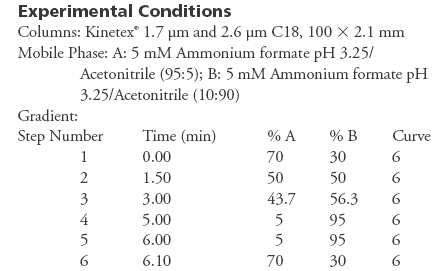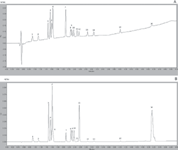Significant Costs Savings Achieved Through the Development of a New Analytical Method for Residual API Analysis, with a Kinetex® 1.7 μm Core-Shell UHPLC Column
This study demonstrates how the ultrahigh-performance of 1.7 ?m core-shell columns can be utilized in the laboratory in order to realize significant cost savings.
This study demonstrates how the ultrahigh-performance of 1.7 μm core-shell columns can be utilized in the laboratory in order to realize significant cost savings.
The pharmaceutical industry has been undergoing extensive changes in recent years, primarily brought upon by the need to reduce operational costs. This project resulted in an annual cost saving of €250,000 to €350,000 Euros, based upon the reduction in analysts, solvents, wastes, and equipment overheads.

Flow Rate: 0.4 mL/min
Temperature: 50 °C
Detector: PDA 210-300 nm, extracted channels 225 nm and 280 nm
Instrument: Waters® ACQUITY® equipped with PDA
Sample: 1. Antidepressant drug (containing an HCl salt); 2. Hormone therapy #1 (containing a salt); 3. SERM drug (containing a basic functional group); 4. CNS drug (containing basic functional group); 5. PPI drug (containing basic functional group); 6. CNS drug (containing basic functional group); 7. CNS drug (containing basic functional group); 8. Hormone therapy #2 (neutral); 9. Oral contraceptive hormone #1 (neutral); 10. Hormone therapy #3 (neutral); 11. Oral contraceptive hormone #2 (neutral); 12. Hormone therapy #4 (neutral); 13. Oral contraceptive hormone (neutral); 14. Hormone therapy #5 (neutral); 15. Hormone therapy #6 (acetate salt of 14); 16. Immunosuppressant drug (macromolecule, containing basic functional group)
Swab Extraction Procedure
A swab containing residual API from different production surfaces was extracted with 2 mL of a solution containing a mixture of 1:1 acetonitrile:water and shaken for 5 min.
Results
The active pharmaceutical ingredients (APIs) used in these experiments are a mixture of organic salts, organic bases, and neutral organic compounds. The analysis was performed on a Phenomenex® Kinetex® 1.7 μm C18 column under gradient conditions with a flow rate of 0.4 mL/min. Two different UV wavelengths were used for quantification, 225 nm as shown in Figure 1a and 280 nm as shown in Figure 1b.

Figure 1: Sample chromatogram at 225 nm (a) and 280 nm (b) using a Kinetex C18 1.7 μm, 100 à 2.1 mm.
A reduced run time of 6 min compared to 10 to 20 min in the original method was achieved. The critical pair for separation was compounds 5 and 6, as the closest eluting peaks. However, molecules 5 and 6 are not in the same class of drug and would not routinely be manufactured on the same equipment set and hence seen in the same sample. Therefore, complete resolution was not required.
Conclusion
A new analytical method was developed which is capable of analyzing 16 different API residues from production surfaces. It has been shown that the 1.7 μm Kinetex 100 × 2.1 mm column was capable of resolving 16 different chemical entities with a 6 min run time. This new analytical method will be used to replace 16 older methods, thereby facilitating an annualized cost saving for the site of €320,000.
For complete details request Laboratory Case Study by Andrew Charles and colleagues.
Phenomenex, Inc.
411 Madrid Avenue, Torrance, CA 90501
tel. (310) 212-0555, fax (310) 328-7768
Website: www.phenomenex.com

SEC-MALS of Antibody Therapeutics—A Robust Method for In-Depth Sample Characterization
June 1st 2022Monoclonal antibodies (mAbs) are effective therapeutics for cancers, auto-immune diseases, viral infections, and other diseases. Recent developments in antibody therapeutics aim to add more specific binding regions (bi- and multi-specificity) to increase their effectiveness and/or to downsize the molecule to the specific binding regions (for example, scFv or Fab fragment) to achieve better penetration of the tissue. As the molecule gets more complex, the possible high and low molecular weight (H/LMW) impurities become more complex, too. In order to accurately analyze the various species, more advanced detection than ultraviolet (UV) is required to characterize a mAb sample.















